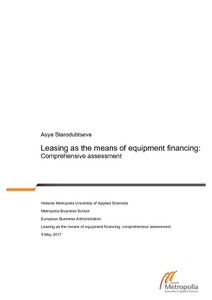Leasing as the means of equipment financing : Comprehensive assessment
Starodubtseva, Asya (2017)
Starodubtseva, Asya
Metropolia Ammattikorkeakoulu
2017
All rights reserved
Julkaisun pysyvä osoite on
https://urn.fi/URN:NBN:fi:amk-201705188955
https://urn.fi/URN:NBN:fi:amk-201705188955
Tiivistelmä
A Lease is a contract that allows a certain entity to use property that it doesn’t possess in exchange for series of periodic payments to the owner. Thereby, a lessee - an entity such permit is granted to, can generate earnings from its use. In essence, leasing is simply another method of financing in contrast to bank loans, private placements and other.
The Survey of Corporate Leasing Analysis conducted by Tarun K. Makherjee in 1988 showed that for the firms surveyed (Fortune 500) leasing was not a predominant means of financing an asset, moreover, only 14% of companies expected their lease levels to increase. Despite this fact, more equipment is financed today by equipment leases that by … any other method of equipment financing. For this reason, understanding the mechanics of lease financing as well as its benefits and drawbacks in relation to other methods is an issue of high significance. For this reason, description of the mechanics of lease financing and its comprehensive assessment in comparison to other alternatives is the main research focus of this paper.
While some assume that the principal reason for leasing to exist is the possibility to derive different cost benefits from owning an asset, in reality leasing is more that just financing vehicle. Apart from exploiting the tax benefits, companies can also use leasing to promote the sales of their products and secure their receivable portfolios. Benefits of leasing vary greatly depending on the company and the type of lease, however, as a general rule “firms have found financing their product via leasing a highly profitable business”.The company examples include, but not limited to IBM, Hewlett-Packard, Cisco and many others.
The Survey of Corporate Leasing Analysis conducted by Tarun K. Makherjee in 1988 showed that for the firms surveyed (Fortune 500) leasing was not a predominant means of financing an asset, moreover, only 14% of companies expected their lease levels to increase. Despite this fact, more equipment is financed today by equipment leases that by … any other method of equipment financing. For this reason, understanding the mechanics of lease financing as well as its benefits and drawbacks in relation to other methods is an issue of high significance. For this reason, description of the mechanics of lease financing and its comprehensive assessment in comparison to other alternatives is the main research focus of this paper.
While some assume that the principal reason for leasing to exist is the possibility to derive different cost benefits from owning an asset, in reality leasing is more that just financing vehicle. Apart from exploiting the tax benefits, companies can also use leasing to promote the sales of their products and secure their receivable portfolios. Benefits of leasing vary greatly depending on the company and the type of lease, however, as a general rule “firms have found financing their product via leasing a highly profitable business”.The company examples include, but not limited to IBM, Hewlett-Packard, Cisco and many others.
